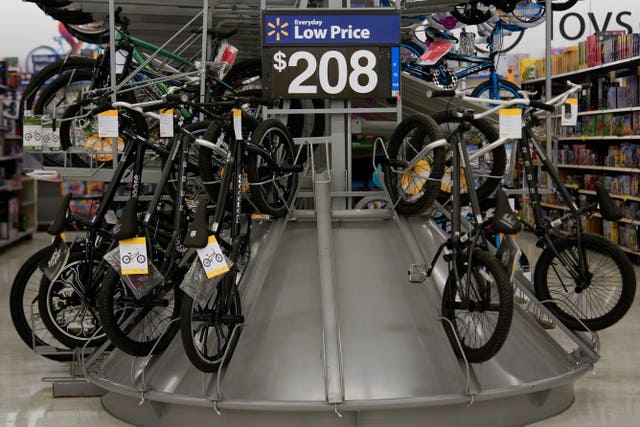Walmart says it has to raise prices ‘given magnitude of tariffs’
The US retailer has built in hedges against some tariff threats.

Walmart’s first-quarter profit slipped, and it said it must raise prices due to higher costs from tariffs implemented by US president Donald Trump.
The nation’s largest retailer posted strong quarterly sales on Thursday and said it expects sales growth of 3.5% to 4.5% in the second quarter.
But like many other US companies, it did not issue a profit outlook for the quarter because of the chaotic environment, with stated US tariff policies changing constantly. The company maintained its full-year guidance issued in February.
Many Americans have pulled back on spending as they grow uneasy about the economy.
Government data revealed slowing sales growth for retailers on Thursday.
Walmart said on Thursday that its consumers remain cautious and selective.
Mr Trump’s tariffs on China and other countries threaten the low-price model that is at the core of Walmart’s success.
Mr Trump’s threatened 145% import taxes on Chinese goods were reduced to 30% in a deal announced on Monday, with some of the higher tariffs on pause for 90 days.
Retailers and importers had largely stopped shipping shoes, clothes, toys, and other items with the duties so high, but many will now resume importing from China in the narrow window, hoping to avoid sparse shelves this autumn.
Yet many retailers say they must raise prices to absorb tariff costs.

And they are also bracing for higher shipping costs fuelled by a surge of companies scrambling to get their goods on ships to the US.
Walmart has built in hedges against some tariff threats. Two-thirds of Walmart’s merchandise is sourced in the US, with groceries driving much of that. Groceries account for roughly 60%, of Walmart’s US business.
Still, Walmart is not immune.
“We will do our best to keep our prices as low as possible,” Walmart’s chief executive Doug McMillon told industry analysts on Thursday.
“But given the magnitude of the tariffs, even at the reduced levels announced this week, we aren’t able to absorb all the pressure given the reality of narrow retail margins.”
Mr McMillon said price increases on the shelves will feel more gradual, but they had already begun as early as April, and they accelerated in May. The company said it has been focused on back-to-school receipts.
He added that it imports general merchandise from all over the world from dozens of countries. But China, in particular, represents a big chunk of volume in certain categories such as electronics and toys.
Tariffs on countries such as Costa Rica, Peru and Colombia are raising costs on groceries including bananas, avocados, coffee and roses, he said.
Walmart is absorbing costs on general merchandise within departments and not yet passing along rising costs in some cases.
Walmart is also asking suppliers to change input materials for components, for example, using fiberglass instead of aluminium, which Mr Trump hit with tariffs in early March.
Walmart earned 4.45 billion US dollars (£3.35 billion), or 56 cents per share, in the quarter ended April 30, down from 5.10 billion dollars (£3.8 billion), or 63 cents per share, in the same period last year.
Adjusted earnings per share were 61 cents, exceeding the 58 cent projections from industry analysts, according to FactSet.
Revenue rose 2.5% to 165.61 billion dollars (£124.72 billion), just short of analyst estimates.
Walmart’s US comparable sales — those from established physical stores and online channels — rose 4.5% in the second quarter, although that’s slowed from a 4.6% bump in the previous quarter, and a 5.3% increase in the third quarter of 2024.
Shares fell 4% at the opening bell on Thursday.

Business was fuelled by health and wellness items as well as groceries. Sales were weaker in home and sporting goods, which was offset by robust sales of toys, automotive goods and children’s clothing, the company said.
Global e-commerce sales rose 22%, up from 16% in the previous quarter.
Walmart is among the first major US retailers to report financial results and the numbers can provide a hint as to the mood of the American shopper and how the tariffs are impacting its business.
Earlier this month, Amazon announced higher first-quarter profit and sales, underscoring the online giant’s hold on shoppers looking for low prices in an uncertain economy.
Amazon brought in foreign goods before Mr Trump’s tariffs took effect. And chief executive Andy Jassy said that many of its third-party sellers did the same.





